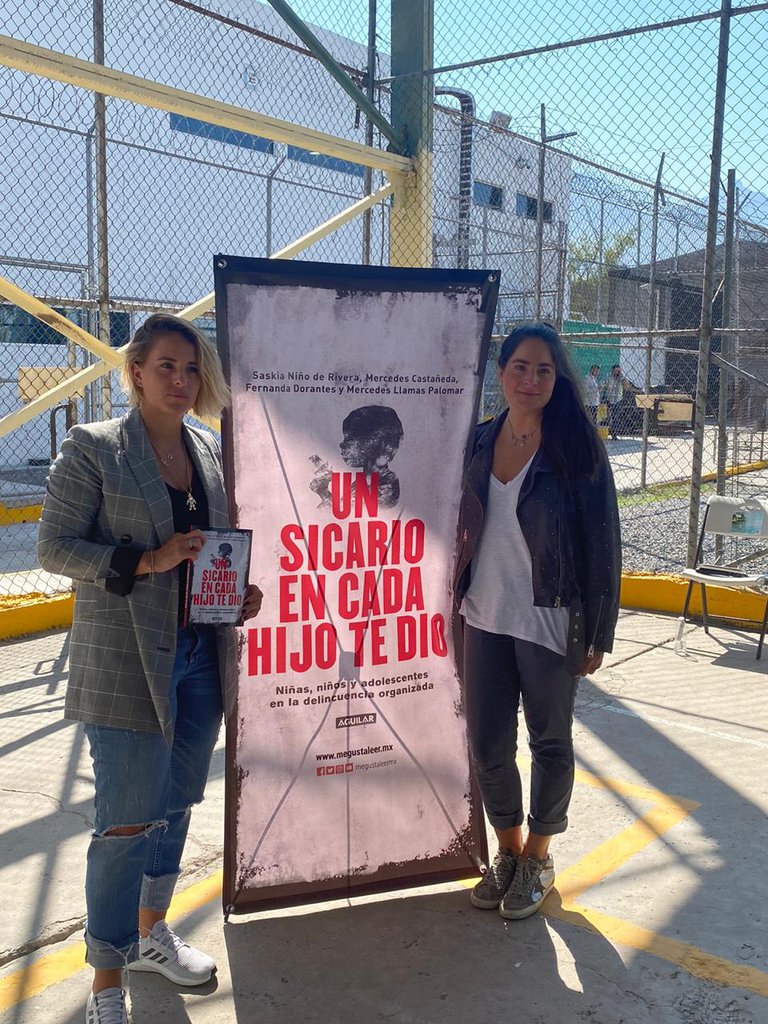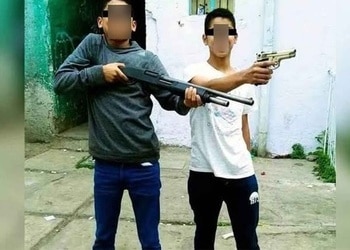Between 35,000 and 45,000 children are currently trapped and exploited by criminal groups in Mexico, according to Saskia Niño de Rivera, director of Reinserta, a foundation working to help reform the country’s prison system and create opportunities for former inmates.
Yet much of the country’s coverage of these children has focused on more sensationalist elements, popularizing phrases such as niño sicario (child hitman) or glorifying body counts.
A new book, Un sicario en cada hijo te dio (A Hitman in Every Child), co-written by Niño de Rivera, recounts the lives of a number of these minors while discussing the almost complete lack of options provided to them in Mexico. InSight Crime sat down with Niño de Rivera to discuss child recruitment dynamics in Mexico, what paths exist to help them reintegrate into society and the impact of the coronavirus pandemic.

InSight Crime (IC): How did the investigation for the book get started?
Saskia Niño de Rivera (SNR): At Reinserta, we have been working for seven years with minors in trouble with the law, creating models for their social reintegration. As a foundation, we pay attention to the stories of these young people and their experiences. It was overwhelming because we began to see an increase in cases, as we explain in the book. Mercedes Castañeda (the book’s co-author) and I asked ourselves a lot why more people are not talking about this? Why are people not outraged by what is happening with children being armed, children killed while working as hitmen or in organized crime? When we were sought out by the publishing house, we saw it as an opportunity and a vehicle to tell these stories.
IC: There does not seem to be as much discussion in Mexico about criminal structures recruiting children as there is in Colombia, for example
SNR: It is a subject that Mexico has not wanted to address. The truth is that authorities have completely ignored this reality. They do not want to confront it and we think that is a serious mistake.
SEE ALSO: Going Door to Door: Mexico City’s Response To Child Recruitment
IC: What are the different recruitment dynamics that you came across during your investigation?
SNR: Many people believe that recruitment refers to children who are forcibly kidnaped and taken away to centers to train to be hitmen. This is not true. There are several forms of recruitment.
One is forced recruitment where children do not have another option: they are kidnapped or sold by their parents to an organized crime group. But often, other risk factors are at play due to the environment in which these children grow up. These include hunger, extreme violence at home, lack of access to education and other situations of marginalization.
IC: Could you tell me about a specific case of child recruitment that really had an impact on you?
SNR: Damián’s case really had an impact on me. His story is discussed in the book. We were contacted to help get him out as they were going to kill him. It is a story that showcases the inefficiency of the state and how people can forget about a child. Damián was sold at just six years old, he was forced to work and ended up moving drugs stashed inside furniture. Then Los Zetas caught him in Tamaulipas. They killed the person who was driving the bus – who Damián considered to be his brother – and kidnapped Damián. He began living out of trash bins and, by age eight, he was already consuming drugs and involved in crime.
When we spoke with him, he could not remember ever being sober for two days straight. He had no name, they gave him an alias. He did not know how old he was, they had to check his teeth to determine how old he was when he was detained.
IC: How has the COVID-19 pandemic affected the recruitment of minors?
SNR: Schools can be both a protective factor or a risk factor, depending on their conditions. Due to the pandemic, schools remain closed, which has limited the chances for children and teenagers to find spaces for social interaction. In addition, this has made the social inequality among Mexican households even starker, in terms of access to new technologies.
These inequalities leave the door open for organized crime. Children and teenagers spending more time at home may be more exposed to violence and to economic, technological, social and educational shortcomings. While there are no updated statistics to prove that child recruitment has gone up in recent months, it is reasonable to believe that the pandemic has exacerbated the aforementioned factors and that criminal groups have taken advantage of this.
IC: In Colombia, we have seen that children are often first trained as mules and lookouts and eventually can ascend to the ranks of soldiers or hitmen. How easy is it for a child to ascend criminal ranks in Mexico?
SNR: Whether a child ascends the criminal ranks has to do with their own impulses. They are less cautious than adults and this provides an area of opportunity within criminal groups. These minors are quickly hooked on drugs, which predisposes them to other tasks.
Something we have observed is that minors can scale the criminal ranks very quickly. We have not seen them remain as lookouts for years at a time. However, just as they quickly rise in the ranks, they can quickly end up getting killed.
IC: There has been ample coverage about the participation of young people in drug trafficking but less in other criminal economies, such as human trafficking. How different are the factors leading to child recruitment for less visible criminal economies?
SNR: For example, in human trafficking, the girls are manipulated, kidnapped and “made to fall in love” and the boys are kidnapped and sold. In these cases of human trafficking or labor exploitation, the children are forced far more than in drug trafficking. Children exploited for work are forced to do so and to hand over the money at the end of the day. A boy forced to sell stuff on the street has no other option as opposed to a teenager who chooses [to get involved in organized crime] to earn a salary.
IC: What opportunities exist in Mexico for minors who manage to get out or escape the criminal groups?
SNR: The public sector offers limited educational and work opportunities. For education, there are few alternatives that effectively accompany teenagers and take into account their lack of formal education.
But employment offers are also limited. There are few job opportunities for former criminals and many companies only offer a minimum wage. Therefore they often resort to informal employment, as street vendors for example.
Civil society, for its part, is developing strategies directed at preventing child recruitment by organized criminal groups, establishing plans and programs that meet the needs of this population. At Reinserta, we have managed to develop and consolidate a program called Social Reintegration for Adolescents and Young People that establishes five main avenues for intervention: education, mental health, employment opportunities, restorative justice and self-care.
Likewise, civil society groups already exist working on effective programs to demobilize and reintegrate this population.
IC: What rehabilitation tools exist and how effective are they?
SNR: The evidence we have comes from international experience in countries like Italy, Colombia, Brazil, Australia, the United States, the Philippines and Africa. Good practices are developed from the beginning of the demobilization process to complete reintegration. In order to support these minors, the programs focus on the development of security and relocation protocols, comprehensive demobilization programs, restorative justice and demobilization, renewal and reintegration.
Italy has a reintegration program that focuses on having the minors complete a personalized educational project developed by social workers, with the support of other institutions. This program has turned out to be effective. In the Philippines, reintegration is focused on strengthening psychosocial skills, accompanied by programs to support reintegration into productive life.
SEE ALSO: Mexico Criminal Groups Increase Child Recruitment Tactics
IC: How many of these success stories have there been in Mexico?
SNR: In Mexico, success stories related to the rehabilitation of minors are scarce. At Reinserta, we have implemented a Social Reinsertion Model for teenagers who have committed high-impact crimes. Through this Model, we have seen favorable results in reducing recidivism, in reducing the risk factors that lead to recidivism and in increased levels of employment and education.
We are creating a demobilization manual, laying the foundations to achieve successful medium to long-term success for children once involved in organized crime.
IC: What resources and tools does the Mexican government have to confront this problem?
SNR: Combating the recruitment of children within organized crime requires transversal action. It is too easy to say that more education will lead to fewer children becoming involved in drug trafficking. To start, there could be training provided for teachers to help them detect the risk factors among children.
We see a lot of cases of children being kicked out of school. But when you investigate in-depth, it turns out the children experienced violence at home and behaved poorly at school as a consequence. But when they were most in need of being rescued, they were abandoned.
Mexico’s education system appears to be going overboard in this aspect, many of the young people we work with were expelled from school.
We also need to strengthen the National System for the Integral Development of the Family (Sistema Nacional para el Desarrollo Integral de la Familia – DIF). It seems absurd to me that we do not have a stronger comprehensive protection system for children that can act swiftly to protect those most at risk.
Public policy and social programs have to work together as part of a comprehensive strategy.
IC: ¿What recommendations do you have for investigators or journalists interested in covering this topic? How can they avoid sensationalizing such a sensitive issue?
SNR: The most important thing is to protect the children at all times and not to criminalize them. At times, the media has been a participant in this with detonating headlines with phrases like “child hitman.” The discourse should not be directed at criminalizing the kids but on how to resolve the problem in a comprehensive way. Otherwise, this can promote hate and only make it more difficult to attack the issue.
We also have to keep talking about the subject. Discussing children involved in violence is hard and it can be tempting to stay quiet. But we have to give the issue visibility.

